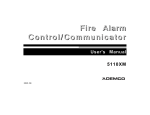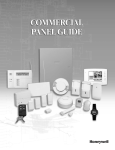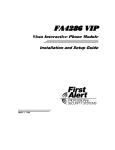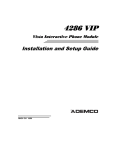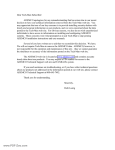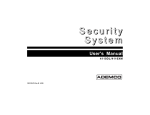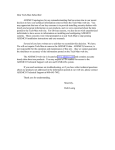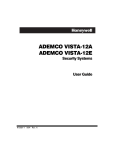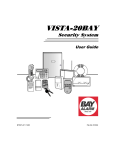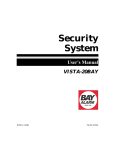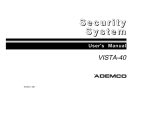Download ADEMCO 5110XM User guide
Transcript
5110XM
Control / Communicator
User Guide
N8028V2 3/10 Rev A
Your Honeywell security system is designed for use with devices manufactured or approved
by Honeywell for use with your security system. This system is not designed for use with
any device that may be attached to your security system's keypad or other communicating
bus if Honeywell has not approved such device for use with your security system. Use of any
such unauthorized device may cause damage or compromise the performance of your security
system and affect the validity of your Honeywell limited warranty.
When you purchase devices that have been manufactured or approved by Honeywell, you
acquire the assurance that these devices have been thoroughly tested to ensure optimum
performance when used with your Honeywell security system.
TABLE OF CONTENTS
SYSTEM OVERVIEW ....................................................................................................................... 1
General........................................................................................................................................ 1
Zones ........................................................................................................................................... 1
Fire & Emergency Protection..................................................................................................... 1
Alarms ......................................................................................................................................... 1
Alarm Memory ............................................................................................................................ 2
ABOUT THE BUILT-IN INDICATORS .............................................................................................. 2
ABOUT THE OPTIONAL KEYPADS ................................................................................................ 3
General ........................................................................................................................................ 3
Keypad Displays .......................................................................................................................... 3
FUNCTIONS OF THE REMOTE KEYPAD ....................................................................................... 4
FIXED-WORD KEYPAD DISPLAYS................................................................................................. 5
REMOTE KEYPAD USER CODES .................................................................................................. 6
General ........................................................................................................................................ 6
To Assign, Change, or Delete User Codes .................................................................................. 6
NORMAL STANDBY OPERATION................................................................................................... 6
FIRE ALARM PROTECTION ............................................................................................................ 7
General ........................................................................................................................................ 7
In Case Of Fire............................................................................................................................. 7
Silencing and Resetting a Fire Alarm ........................................................................................... 7
SUPERVISORY CONDITIONS......................................................................................................... 8
General ........................................................................................................................................ 8
Silencing and Resetting a Supervisory Indication ........................................................................ 8
TROUBLE CONDITIONS.................................................................................................................. 9
General ........................................................................................................................................ 9
Silencing and Resetting a Trouble Indication ............................................................................. 10
ACTIVATING A FIRE DRILL TEST................................................................................................. 10
Using the # + 6 + 9
Keys ................................................................................................... 10
QUICK GUIDE TO SYSTEM FUNCTIONS..................................................................................... 11
SUMMARY OF AUDIBLE/VISUAL NOTIFICATION ....................................................................... 12
STATEMENTS................................................................................................................................ 13
LIMITATIONS STATEMENT........................................................................................................... 15
SERVICING INFORMATION .......................................................................................................... 16
WARRANTY ..................................................................................................................... Back Cover
SYSTEM OVERVIEW
This manual is a step-by-step guide that will acquaint you with the system's features and
benefits. It defines the components and their functions, describes their operation, and
instructs you with normal and emergency procedures.
Keep this manual in a convenient place so that you can refer to it as necessary.
General
Your Honeywell system is a commercial fire alarm control/communicator. It monitors, on an
around-the clock basis, the various fire alarm warning, emergency alarm warning and fire
sprinkler system supervisory sensors that have been installed in your system. When the
control detects an alarm, supervisory, or trouble condition, it automatically triggers an onpremises warning indication and transmits a message to a central station over the telephone
line so that appropriate action can be taken.
The control features a built-in warning buzzer and LED indicators which provide the onpremises warning indication. In addition, your system may include an optional remote
keypad and/or external alarm warning sounders which will provide additional on-premises
warning indications. Please disregard references to these devices, if they were not installed
in your system.
This manual is designed to help you become comfortable operating your system. Each
function is explained in step-by-step detail. We recommend you read the SYSTEM
OVERVIEW section to become familiar with the terminology and the basic features of the
system.
Zones
Your system has five protection zones. Your installer has assigned each of your system's
sensing devices to one of these zones. For example, warehouse smoke detectors may have
been assigned to zone 01, a fire sprinkler water valve supervisory switch may have been
assigned to zone 02, etc. If a remote keypad was installed in your system, it will display
these zone numbers when an alarm, supervisory or trouble condition is detected, so that the
nature and location of the fault can be pinpointed.
Fire & Emergency Protection
The fire and emergency protection portions of your system are always on and will sound an
alarm if an alarm condition is detected.
Alarms
When an alarm occurs, the control's buzzer, the keypad and external sounders will sound,
and a message at the keypad will identify the zone(s) causing the alarm. In addition, an
alarm message will be sent to the connected central monitoring station. You may stop the
sound by pressing the SILENCE/RESET button at the control, or by entering your User Code
+ [OFF] key at your keypad.
–1–
Alarm Memory
When an alarm, supervisory or trouble condition occurs, the keypad displays the number(s)
of the zone(s) that caused the problem, and displays the type of condition present (ex. Fire,
Alarm, Supv., Check). The display remains until it is cleared by entering your User Code +
[OFF] key a second time or by pressing the SILENCE/RESET button a second time if no
keypad is present.
ABOUT THE BUILT-IN INDICATORS
The LED indicators, SILENCE/RESET button and WARNING buzzer (shown below) are
located on the control's main board inside the control's enclosure. The LED indicators are
visible through a viewing window on the door of the enclosure. The enclosure door must be
opened with the supplied key to gain access to the SILENCE/RESET button.
LED Indicators
AC POWER – Lights when AC power is present.
Turns off when AC power is low or not present
and system is operating from battery power.
BUZZER
BATTERY TROUBLE – Lights when battery
SILENCE/RESET
BUTTON
power is low or disconnected. Turns off when
AC POWER
battery is OK.
(GREEN)
COMMUNICATION FAILURE – Lights when
BATT TROUBLE
(YELLOW)
attempts to transmit a message to the central
COMM FAIL
station have failed. Remains unlit when there
(YELLOW)
are no problems with central station message
LINE FAULT
transmission.
(YELLOW)
SILENCED
LINE FAULT – Lights when either the main or
(YELLOW)
back-up phone lines are faulted. Remains unlit
BACKUP DIALER MAIN DIALER
SUPERVISORY
LINE SEIZE
LINE SEIZE
when both phone lines are okay.
(YELLOW)
ALARM
SILENCED – Lights when the built-in warning
(RED)
buzzer, the remote keypad buzzer and external
TROUBLE
alarm sounders have been silenced. Otherwise
(YELLOW)
remains unlit.
SUPERVISORY – Lights when a Fire
Supervisory condition occurs in the system. Turns off when the supervisory condition is fixed
and the Silence/Reset button is pressed.
ALARM – Lights when a Fire Alarm occurs in the system. Turns off when the alarm is fixed
and the Silence/Reset button is pressed.
TROUBLE – Lights when a Fire Trouble condition occurs in the system. Turns off when the
trouble condition is fixed and the Silence/Reset button is pressed.
Warning Buzzer – Produces a temporal pulsing sound for fire alarms, steady sound for
emergency alarms, and rapid on/off pulsing sound for supervisory and trouble conditions.
LED-001-V1
–2–
Silence/Reset Button – Press to silence the built-in warning buzzer, the remote keypad
warning buzzer and the external alarm sounder. A second press resets faulted smoke
detectors and resets LED indicators if associated fault conditions have been corrected.
Main Dialer Line Seize – Lights when control is transmitting a message to the central
station on the main phone line.
Backup Dialer Line Seize – Lights when control is transmitting a message to the central
station on the backup phone line.
ABOUT THE OPTIONAL KEYPADS
General
The optional keypads feature a telephone style (digital) keypad and a Liquid Crystal Display
(LCD) which shows the nature and location of all occurrences.
The keypads feature a built-in sounder, which emits the same alarm sounds as the control's
built-in warning buzzer during alarm conditions.
The keypad's display screen displays the same indications as the control's built-in LED
indicators, and in addition, displays the zone number of faulted zones as well as the type of
fault (i.e. alarm, supervisory or trouble) present. The telephone style keypad keys allow
entry of commands for silencing the warning sounds, resetting faulted smoke detectors,
activating various system
tests, etc.
Keypad Displays
There are two basic types of keypad displays, Alpha and Fixed-Word, either of which may
have been used in your system.
• Alpha Keypad Displays feature a 2-line, 32 character alphanumeric Liquid Crystal
Display (LCD) which can display the nature and location of all occurrences in
friendly English.
• Fixed-Word Keypad Displays are functionally similar to the Alpha Keypads,
except that their LCD display uses pre-designated (fixed) words to identify the
nature and location of occurrences.
Unless stated otherwise, all commands and procedures described herein apply equally to all
keypads.
–3–
FUNCTIONS OF THE REMOTE KEYPAD
DISPLAY WINDOW: Displays zone number and system status messages.
1
OFF Key: Silences audible alarm, supervisory and trouble sounds, and clears visual
display after problem's correction.
6
BYPASS Key: Removes individual protection zones from being monitored by the
system. (Installer only function.)
8
CODE Key: Used to assign additional 4-digit user codes.
#
Key: Used to activate fire drill. (Enter user 2's code + [#] + [69])
0 – 9 Keys: Used to enter your 4-digit user code, which must be entered before pressing
the OFF, BYPASS, CODE or [#] keys.
ARMED INDICATOR: Not Used.
READY INDICATOR: Not Used.
INTERNAL SOUNDER: Sound is: slow on/off pulsing for fire alarms, steady dual-tone for
emergency alarms, and rapid on/off pulsing for supervisory and trouble conditions.
IMPORTANT! When entering codes and commands, sequential key depressions must be
made within 2 seconds. If 2 seconds elapses without a key depression, the entry is aborted
and must be repeated from its beginning.
ARMED
1
OFF
2
AWAY
3
STAY
READY
4
MAX
5
TEST
6
BYPASS
7
INSTANT
8
CODE
9
CHIME
READY
0
6160-00-001-V0
#
–4–
FIXED-WORD KEYPAD DISPLAYS
FIRE – Appears when a fire alarm is detected. Accompanied
by a display of the zone # in alarm.
ALARM – Appears when any type of alarm is detected. "FIRE"
AC
AWAY SUPV NOTEST
BYPASS
also appears when a fire alarm is detected. Accompanied by a
NOT READY
ALARM STAY CHIME BAT
display of the zone # in alarm.
FIRE CHECK INSTANT
SUPV – Appears when a fire sprinkler system supervisory
condition is detected. Accompanied by a display of the zone #
FIXED-WORD DISPLAY
having the supervisory condition.
CHECK – Appears when a fire zone wiring fault is detected at any time. Also appears
when certain system problems such as phone line problems are detected. Accompanied by a
display of the zone # in trouble.
AC – Appears when AC power is present.
NO AC – Appears when AC power is low, or not present. System is operating from backup
battery power.
BAT – Appears when backup battery is low or disconnected.
TEST – Appears when the system is operating in one of its test modes (such as the fire drill
test mode).
BYPASS – Appears when one or more zones have been bypassed and are no longer
operational.
CC – Appears when a site initiated download occurs.
FC – Appears when a message (alarm, trouble, etc.) fails to reach the central station.
CF – Appears when the system is in the fire walk test mode.
dF – Appears when the system is in the fire drill test mode.
–5–
REMOTE KEYPAD USER CODES
General
If your system has a remote keypad installed, your installer will have programmed a 4-digit
user code (known as User Number 2 code) that can be entered at your keypad to silence/reset
alarms and activate the fire drill test. This code may also be used to assign up to four other
user codes (known as User Number 3–6 codes).
The User Number 3–6 codes are intended for users who need limited and/or temporary
control over system operation. These codes can perform the same functions as the User
Number 2 code except for assigning user codes and activating the fire drill test.
To Assign, Change, or Delete User Codes
User Number 2 can change, but not delete, their own code and can assign, change, or delete
codes for User Numbers 3–6.
User Numbers 3–6 cannot assign, change, or delete user codes.
1. Enter the User Number 2 code and press the CODE key.
2. Enter a single-digit User Number (2–6) for the user whose code is to be assigned,
changed, or deleted.
3. If assigning or changing a user's code, enter the new 4-digit code for that user.
The keypad will beep once, indicating that the new code has been accepted.
If deleting a user's code, perform steps 1 and 2 and then stop. After a few
moments the keypad will beep once, indicating that the existing code has been
deleted.
NORMAL STANDBY OPERATION
Your system provides the following indications when in normal operation and there are no
alarm, supervisory, or trouble conditions present:
•
•
•
The control's AC POWER LED is lit.
The control's built-in buzzer and keypad warning buzzer and external alarm
sounders are off.
The Alpha keypad's LCD display.
Fixed Word keypad LCD display.
AC
–6–
FIRE ALARM PROTECTION
General
Your system may have sensors which detect fire alarm conditions such as smoke detectors,
heat detectors, sprinkler waterflow sensors, etc. Your system monitors these sensors 24
hours a day and provides a number of indications when a fire alarm condition is detected.
In Case Of Fire
WHEN A FIRE ALARM CONDITION IS DETECTED, EVACUATE ALL
OCCUPANTS FROM THE PREMISES IMMEDIATELY AND NOTIFY YOUR
LOCAL FIRE DEPARTMENT.
Your system provides the following indications when a fire alarm condition is detected:
• The control's buzzer and keypad buzzer produces a slow on/off pulsing sound.
•
The external fire alarm sounders produce either a steady sound or temporal pulsing
sound depending on what your installer selected. Check the appropriate box.
STEADY SOUND
•
TEMPORAL PULSING SOUND
The keypad LCD displays the word "FIRE" (Alpha) or "FIRE ALARM" (Fixed-Word)
along with the number of the zone in alarm.
FIRE O5
FILE ROOM
•
ALPHA
FIXED-WORD
A fire alarm message is sent to the central station.
If your system has a keypad with a FIRE alarm emergency key, then these indications
may be manually triggered by pressing this key for at least 2 seconds, (or the
corresponding key pair), should you become aware of a fire emergency before your
detectors sense the problem.
Silencing and Resetting a Fire Alarm
To silence the control's buzzer, the keypad buzzer and external alarm sounders:
Press the control's SILENCE/RESET button or enter your User Code
followed by the OFF key at the keypad.
The control's "SILENCED" LED lights and the keypad's LCD will display "FIRE ALARM
SILENCED" (Alpha) or "SF" (Fixed-Word) to indicate that a fire alarm condition may still be
present. The Alpha keypad will display the number of the zone in alarm as a Memory of
Alarm indication. The fixed-word keypad alternates the zone number in alarm with the
"SF" display.
–7–
ALPHA
FIXED-WORD
To reset your system's smoke detectors and the keypad Memory of Alarm display (after heat
or smoke is no longer present):
First determine and correct the cause of the fire alarm condition (e.g., fan smoke from the
smoke detector chamber, reset the pull station, etc.) and then:
Press the control's SILENCE/RESET button again or re-enter your User
Code plus the [OFF] key at the keypad.
SUPERVISORY CONDITIONS
General
If your building has a fire sprinkler system, your installer may have installed a sensor that
monitors the sprinkler system (e.g., to determine whether the main water gate valve is open
or that there is adequate water pressure, etc.). Your system provides the following
indications when a supervisory condition is detected.
CALL YOUR INSTALLER IMMEDIATELY FOR SERVICE WHEN A
SUPERVISORY INDICATION APPEARS!
• The control's buzzer and the keypad buzzer both produce a rapid on/off pulsing
sound.
• The keypad LCD (Fixed-Word) displays the word "SUPV" and the number of the zone
with the supervisory condition. Alpha keypads also display a description of the zone.
ALPHA
•
FIXED-WORD
A supervisory message is sent to the central station.
Silencing and Resetting a Supervisory Indication
To silence the control and keypad buzzers:
Press the control's SILENCE/RESET button or enter your User Code, +
the OFF key.
–8–
The keypad's LCD will display the number of the zone having the supervisory condition as
a Memory indication.
To reset the keypad supervisory display: First have the cause of the indication
corrected, and then:
Press the SILENCE/RESET button again or re-enter your User Code,
followed by the OFF key.
TROUBLE CONDITIONS
General
Your system monitors each of your protection zones and various aspects of system operation
for problems such as wire breaks, loss of AC power, faulted telephone lines, etc., which
compromise proper alarm signaling operation. Your system provides the following
indications when one of these problems is detected.
CALL YOUR INSTALLER IMMEDIATELY FOR SERVICE, WHEN ANY OF THESE
INDICATIONS APPEAR FOR A CONDITION THAT CANNOT BE CORRECTED BY YOU!
• The control's buzzer and keypad buzzer both produce a rapid pulsing sound.
• The controls AC POWER LED turns off and the keypad LCD displays "AC LOSS"
(Alpha) or "NO AC" (Fixed-Word) when AC power is low or not present.
• The control's BATTERY TROUBLE LED lights and the keypad LCD displays
"SYSTEM LO BAT" (Alpha) or "BAT" (Fixed-Word) when your system's back-up
battery is low or disconnected.
• The controls COMM FAIL LED lights and the keypad LCD displays "COMM
FAILURE" (Alpha) or "FC" (Fixed-Word) when attempts to send a message to the
central station have failed.
• The keypad LCD (Fixed-Word) displays "CHECK" accompanied by a protection zone
number (1–5) or system zone number (6–12) when there is a zone or system related
problem. Alpha keypads also display a description of the zone. The control's LINE
FAULT LED lights if the problem is with the telephone lines.
ALPHA
•
FIXED-WORD
A trouble message is sent to the central station.
Note: If your keypad LCD displays "0C" for more than 5 minutes, then it is not
receiving signals from the control. CALL YOUR INSTALLER IMMEDIATELY FOR
SERVICE.
–9–
Silencing and Resetting a Trouble Indication
To silence the control and keypad buzzers:
Press the control's SILENCE/RESET button or enter your User Code, +
the OFF key.
The keypad's LCD will display the number of the zone in trouble as a Memory indication.
To reset the keypad trouble display: First have the cause of the trouble condition
corrected, and then:
Press the SILENCE/RESET button again or re-enter your User Code,
followed by the OFF key.
ACTIVATING A FIRE DRILL TEST
Using the # + 6 + 9 Keys
This feature can be activated only while no alarm, supervisory, or trouble
condition is present and only User Number 2's code can activate this test.
This test requires that a keypad and external fire alarm sounder be installed.
The test activates the external fire alarm sounders for the purpose of conducting a
fire alarm drill. Your system will remain operational for fire alarm signaling while
this test is active (although no message will be sent to the central station unless an
actual alarm occurs).
To activate the Fire Drill Test enter User Number 2's code, then press the
# + 6 + 9 keys.
The keypad LCD will display "FIRE DRILL ACTIVE (Alpha) or "TEST dF" (FixedWord) and the external fire alarm sounders will produce either a steady or a pulsing
sound while this test is active, depending on what your installer selected.
ALPHA
FIXED-WORD
To terminate the Fire Drill Test enter any User Code, followed by the OFF key.
Your system will also automatically terminate this test if an alarm, supervisory or
trouble condition is detected while it is activated.
– 10 –
QUICK GUIDE TO SYSTEM FUNCTIONS
FUNCTION
PROCEDURE
COMMENTS
Silence Alarm,
Supervisory or
Trouble sounds
Press the SILENCE/RESET button
or
Enter user Code + [OFF] key.
SILENCED LED lights. Memory of fault
remains until cleared.
Keypad displays # of faulted zone.
Reset Smoke
Detectors &
Displays
Press the SILENCE/RESET button
a second time or
Re-enter user Code + [OFF] key.
Will reset only if fault corrected.
Manually Trip
Emergency
Alarms
Press keys [1] & [], or [] & [#], or
[3]&[#],
both at same time.
Key(s) must be enabled by installer.
Fire Drill Test
To activate: Enter User Number 2's
code + [#] + [69].
To turn off: Enter any User Code +
[OFF] key.
Activates external fire alarm sounders.
Assign, change,
or delete user
code.
To assign or change: Enter User To delete: Enter User Number 2's code +
Number 2's code + [CODE] key + [CODE] key + user number (3–6) and
user number (2–6) + new code.
stop. Note: User Number 2 can change
but not delete his/her own code.
– 11 –
SUMMARY OF AUDIBLE / VISUAL NOTIFICATION
ALPHA & FIXED-WORD DISPLAY KEYPADS
SOUND
CAUSE
DISPLAY (Fixed-Word displays are shown
in parentheses)
TEMPORAL
PULSING
Control's buzzer, and
Keypad
(Note: External
sounders can be
temporal or steady as
programmed.)
a. Fire Alarm
a. FIRE ALARM plus number and descriptor of zone in
alarm (FIRE ALARM plus zone #).
b. Fire Drill
b. FIRE DRILL ACTIVE (TEST dF).
STEADY
Burglary
ALARM plus number and descriptor of zone in alarm
(ALARM plus
zone #).
RAPID PULSING
Keypad
a. SUPERVISORY
a. SUPV plus number and descriptor of zone with
SUPV condition (SUPV plus zone #).
b. TROUBLE, Fire
zone problem
b. CHECK plus number and descriptor of zone
(CHECK plus zone #).
c. TROUBLE, System c. AC LOSS (NO AC), or SYSTEM LOW BAT (BAT), or
problem
COMM FAILURE (FC) when associated condition
detected.
– 12 –
FEDERAL COMMUNICATIONS COMMISSION (FCC) STATEMENTS
The user shall not make any changes or modifications to the equipment unless authorized by the Installation
Instructions or User's Manual. Unauthorized changes or modifications could void the user's authority to
operate the equipment.
CLASS B DIGITAL DEVICE STATEMENT
NOTE: This equipment has been tested and found to comply with the limits for a Class B digital device,
pursuant to part 15 of the FCC Rules. These limits are designed to provide reasonable protection against
harmful interference in a residential installation. This equipment generates, uses and can radiate radio
frequency energy and, if not installed and used in accordance with the instructions, may cause harmful
interference to radio communications. However, there is no guarantee that interference will not occur in a
particular installation. If this equipment does cause harmful interference to radio or television reception, which
can be determined by turning the equipment off and on, the user is encouraged to try to correct the interference
by one or more of the following measures:
• Reorient or relocate the receiving antenna.
• Increase the separation between the equipment and receiver.
• Connect the equipment into an outlet on a circuit different from that to which the receiver is connected.
• Consult the dealer or an experienced radio/TV technician for help.
INDUSTRY CANADA (IC) STATEMENTS
This device complies with RSS210 of Industry Canada. Operation is subject to the following two conditions: (1)
This device may not cause harmful interference, and (2) This device must accept any interference received,
including interference that may cause undesired operation.
This Class B digital apparatus complies with Canadian ICES-003.
Cet appareil numérique de la classe B est conforme à la norme NMB-003 du Canada.
IN THE EVENT OF TELEPHONE OPERATIONAL PROBLEMS
In the event of telephone operational problems, disconnect the control by removing the plug from the
RJ31X wall jack. We recommend that your certified installer demonstrate disconnecting the phones on
installation of the system. Do not disconnect the phone connection inside the control/communicator.
Doing so will result in the loss of your phone lines. If the regular phone works correctly after the
control/communicator has been disconnected from the phone lines, the control/communicator has a
problem and should be returned for repair. If upon disconnection of the control/communicator, there is
still a problem on the line, notify the telephone company that they have a problem and request prompt
repair service. The user may not under any circumstances (in or out of warranty) attempt any service
or repairs to the system. It must be returned to the factory or an authorized service agency for all
repairs.
– 13 –
FEDERAL COMMUNICATIONS COMMISSION (FCC) Part 68 STATEMENT
This equipment complies with Part 68 of the FCC rules. On the front cover of this equipment is a label
that contains, among other information, the FCC registration number and ringer equivalence number
(REN) for this equipment. If requested, this information must be provided to the telephone company.
This equipment uses the following jacks: An RJ31X is used to connect this equipment to the
telephone network.
The REN is used to determine the quantity of devices which may be connected to the telephone line.
Excessive RENs on the telephone line may result in the devices not ringing in response to an incoming
call. In most, but not all areas, the sum of the RENs should not exceed five (5.0). To be certain of the
number of devices that may be connected to the line, as determined by the total RENs, contact the
telephone company to determine the maximum REN for the calling area.
If this equipment causes harm to the telephone network, the telephone company will notify you in
advance that temporary discontinuance of service may be required. If advance notice is not practical,
the telephone company will notify the customer as soon as possible. Also, you will be advised of your
right to file a complaint with the FCC if you believe necessary.
The telephone company may make changes in its facilities, equipment, operations, or procedures that
could affect the operation of the equipment. If this happens, the telephone company will provide
advance notice in order for you to make the necessary modifications in order to maintain uninterrupted
service.
If trouble is experienced with this equipment, please contact the manufacturer for repair and warranty
information. If the trouble is causing harm to the telephone network, the telephone company may
request you remove the equipment from the network until the problem is resolved.
There are no user serviceable components in this product, and all necessary repairs must be made by
the manufacturer. Other repair methods may invalidate the FCC registration on this product.
This equipment cannot be used on telephone company-provided coin service. Connection to Party Line
Service is subject to state tariffs.
This equipment is hearing-aid compatible.
When programming or making test calls to an emergency number, briefly explain to the dispatcher the
reason for the call. Perform such activities in the off-peak hours; such as early morning or late evening.
– 14 –
WARNING!
THE LIMITATIONS OF THIS ALARM SYSTEM
While this system is an advanced design security system, it does not offer guaranteed protection
against burglary or fire or other emergency. Any alarm system, whether commercial or residential, is
subject to compromise or failure to warn for a variety of reasons. For example:
• Intruders may gain access through unprotected openings or have the technical sophistication to
bypass an alarm sensor or disconnect an alarm warning device.
• Intrusion detectors (e.g. passive infrared detectors), smoke detectors, and many other sensing devices
will not work without power. Battery operated devices will not work without batteries, with dead
batteries, or if the batteries are not put in properly. Devices powered solely by AC will not work if
their AC power supply is cut off for any reason, however briefly.
• Signals sent by wireless transmitters may be blocked or reflected by metal before they reach the
alarm receiver. Even if the signal path has been recently checked during a weekly test, blockage can
occur if a metal object is moved into the path.
• A user may not be able to reach a panic or emergency button quickly enough.
• While smoke detectors have played a key role in reducing residential fire deaths in the United States,
they may not activate or provide early warning for a variety of reasons in as many as 35% of all fires,
according to data published by the Federal Emergency Management Agency. Some of the reasons
smoke detectors used in conjunction with this System may not work are as follows. Smoke detectors
may have been improperly installed and positioned. Smoke detectors may not sense fires that start
where smoke cannot reach the detectors, such as in chimneys, in walls, or roofs, or on the other side
of closed doors. Smoke detectors also may not sense a fire on another level of a residence or building.
A second floor detector, for example, may not sense a first floor or basement fire. Moreover, smoke
detectors have sensing limitations. No smoke detector can sense every kind of fire every time. In
general, detectors may not always warn about fires caused by carelessness and safety hazards like
smoking in bed, violent explosions, escaping gas, improper storage of flammable materials,
overloaded electrical circuits, children playing with matches, or arson. Depending upon the nature of
the fire and/or the locations of the smoke detectors, the detector, even if it operates as anticipated,
may not provide sufficient warning to allow all occupants to escape in time to prevent injury or
death.
• Passive Infrared Motion Detectors can only detect intrusion within the designed ranges as
diagrammed in their installation manual. Passive Infrared Detectors do not provide volumetric area
protection. They do create multiple beams of protection, and intrusion can only be detected in
unobstructed areas covered by those beams. They cannot detect motion or intrusion that takes place
behind walls, ceilings, floors, closed doors, glass partitions, glass doors, or windows. Mechanical
tampering, masking, painting or spraying of any material on the mirrors, windows or any part of the
optical system can reduce their detection ability. Passive Infrared Detectors sense changes in
temperature; however, as the ambient temperature of protected area approaches the temperature
range of 90° to 105°F (32° to 40°C), the detection performance can decrease.
• Alarm warning devices such as sirens, bells or horns may not alert people or wake up sleepers if they
are located on the other side of closed or partly open doors. If warning devices sound on a different
level of the residence from the bedrooms, then they are less likely to waken or alert people inside the
bedrooms. Even persons who are awake may not hear the warning if the alarm is muffled from a
stereo, radio, air conditioner or other appliance, or by passing traffic. Finally, alarm warning devices,
however loud, may not warn hearing-impaired people or waken deep sleepers.
• Telephone lines needed to transmit alarm signals from a premises to a central monitoring station
may be out of service or temporarily out of service. Telephone lines are also subject to compromise by
sophisticated intruders. (continued)
– 15 –
(continued) WARNING! THE LIMITATIONS OF THIS ALARM SYSTEM
• Even if the system responds to the emergency as intended, however, occupants may have insufficient
time to protect themselves from the situation. In the case of a monitored alarm system, authorities
may not respond appropriately.
• This equipment, like other electrical devices, is subject to component failure. Even though this
equipment is designed to last as long as 10 years, the electronic components could fail at any time.
The most common cause of an alarm system not functioning when an intrusion or fire occurs is
inadequate maintenance. This alarm system should be tested weekly to make sure all sensors and
transmitters are working properly.
Wireless transmitters (used with some systems) are designed to provide long battery life under normal
operating conditions. Longevity of batteries may be as much as 4 to 7 years, depending on the
environment, usage, and the specific wireless device being used. External factors such as humidity,
high or low temperatures, as well as large swings in temperature, may all reduce the actual battery life
in a given installation. This wireless system, however, can identify a true low battery situation, thus
allowing time to arrange a change of battery to maintain protection for that given point within the
system.
Installing an alarm system may make one eligible for lower insurance rates, but an alarm system is not
a substitute for insurance. Homeowners, property owners and renters should continue to act prudently
in protecting themselves and continue to insure their lives and property.
We continue to develop new and improved protection devices. Users of alarm systems owe it to
themselves and their loved ones to learn about these developments.
SERVICING INFORMATION
Your local authorized service representative is the person best qualified to service your alarm
system. Arranging a regular program with that person is advisable. Your local service
representative is:
NAME: _______________________________________________________
PHONE: ______________________________________________________
ADDRESS: ____________________________________________________
– 16 –
NOTES
– 17 –
NOTES
– 18 –
LIMITED WARRANTY
Honeywell International Inc., acting through its Security & Communications business ("Seller"), 2 Corporate Center
Drive, Melville, NY, 11747, warrants its product(s) to be in conformance with its own plans and specifications and to
be free from defects in materials and workmanship under normal use and service for 24 months from the date stamp
control on the product(s) or, for product(s) not having a manufacturer’s date stamp, for 12 months from date of
original purchase unless the installation instructions or catalog sets forth a shorter period, in which case the shorter
period shall apply. Seller's obligation shall be limited to repairing or replacing, at its option, free of charge for
materials or labor, any product(s) which is proved not in compliance with Seller's specifications or proves defective
in materials or workmanship under normal use and service. Seller shall have no obligation under this Limited
Warranty or otherwise if the product(s) is altered or improperly repaired or serviced by anyone other than
Honeywell factory service. Connection of any device(s) to a communicating bus of a Honeywell security system (e.g.,
keypad bus, polling loop) other than those manufactured or approved by Honeywell shall void this warranty. For
warranty service, return product(s) transportation prepaid, to your local authorized Honeywell representative.
THERE ARE NO WARRANTIES, EXPRESS OR IMPLIED, OF MERCHANTABILITY, OR FITNESS FOR A
PARTICULAR PURPOSE OR OTHERWISE, WHICH EXTEND BEYOND THE DESCRIPTION ON THE FACE
HEREOF. IN NO CASE SHALL SELLER BE LIABLE TO ANYONE FOR ANY CONSEQUENTIAL OR
INCIDENTAL DAMAGES FOR BREACH OF THIS OR ANY OTHER WARRANTY, EXPRESS OR IMPLIED, OR
UPON ANY OTHER BASIS OF LIABILITY WHATSOEVER, EVEN IF THE LOSS OR DAMAGE IS CAUSED BY
THE SELLER'S OWN NEGLIGENCE OR FAULT.
Seller does not represent that the product(s) it sells may not be compromised or circumvented; that the product(s)
will prevent any personal injury or property loss by burglary, robbery, fire or otherwise; or that the product(s) will in
all cases provide adequate warning or protection. Customer understands that a properly installed and maintained
alarm system may only reduce the risk of a burglary, robbery, fire, or other events occurring without providing an
alarm, but it is not insurance or a guarantee that such will not occur or that there will be no personal injury or
property loss as a result. CONSEQUENTLY, SELLER SHALL HAVE NO LIABILITY FOR ANY PERSONAL
INJURY, PROPERTY DAMAGE OR OTHER LOSS BASED ON A CLAIM THAT THE PRODUCT(S) FAILED TO
GIVE WARNING. HOWEVER, IF SELLER IS HELD LIABLE, WHETHER DIRECTLY OR INDIRECTLY, FOR
ANY LOSS OR DAMAGE ARISING UNDER THIS LIMITED WARRANTY OR OTHERWISE, REGARDLESS OF
CAUSE OR ORIGIN, SELLER'S MAXIMUM LIABILITY SHALL NOT IN ANY CASE EXCEED THE PURCHASE
PRICE OF THE PRODUCT(S), WHICH SHALL BE THE COMPLETE AND EXCLUSIVE REMEDY AGAINST
SELLER.
This warranty replaces any previous warranties and is the only warranty made by Seller on this product(s). No
increase or alteration, written or verbal, of the obligations of this Limited Warranty is authorized.
2 Corporate Center Drive, Suite 100
P.O. Box 9040, Melville, NY 11747
ÊN8028V2Š
N8028V2 3/10 Rev A
Copyright 2010 Honeywell
International Inc.
www.honeywell.com/security
























